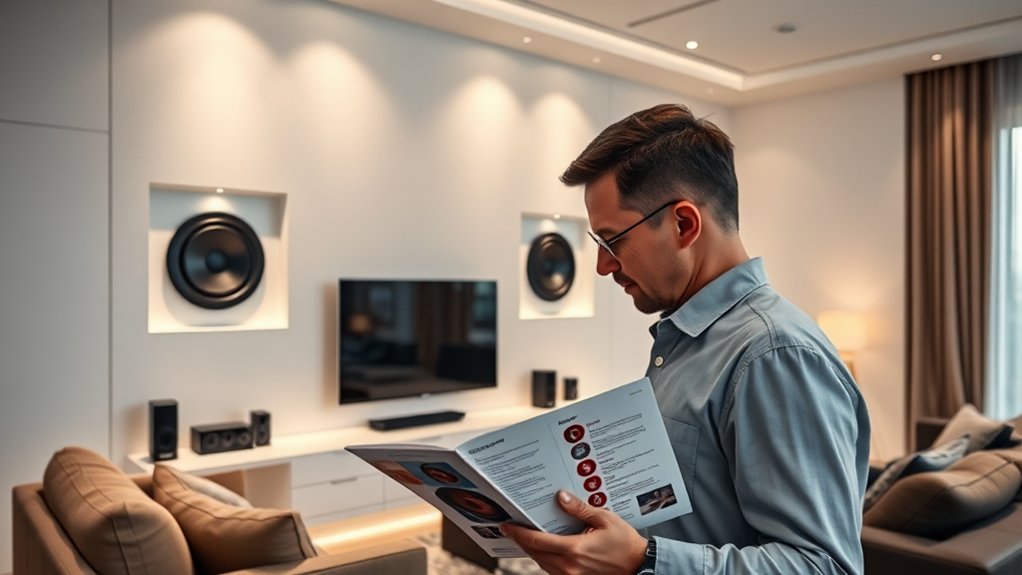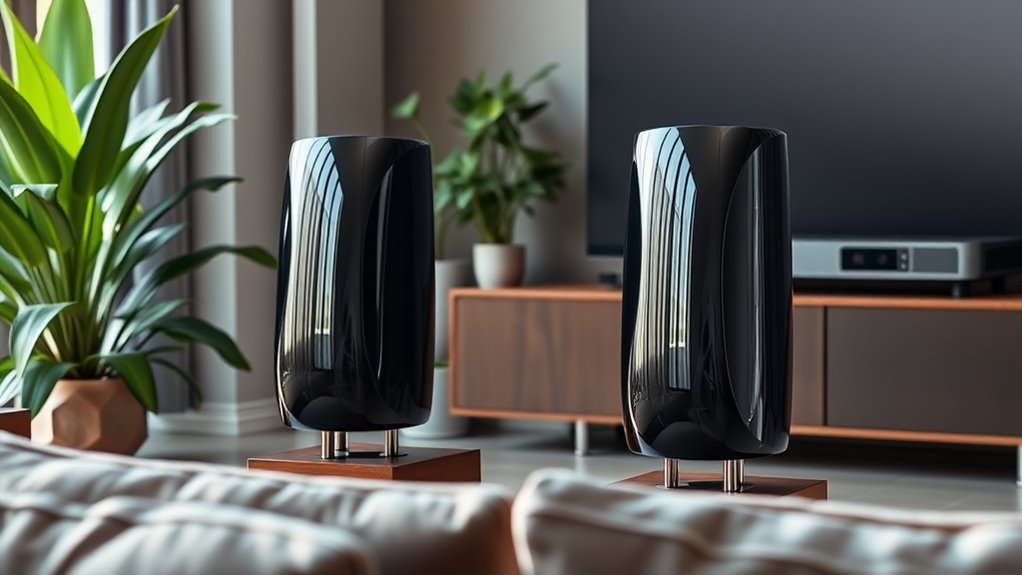When choosing in-wall home theater speakers, consider their design, sound quality, and installation needs. Look for sealed cabinets for consistent output and coaxial drivers to improve sound dispersion. Guarantee good frequency response and sensitivity ratings around 87 dB for balanced performance. Don’t forget installation; check wall cavities, and maintain ideal speaker height. Think of it like fitting puzzle pieces together—getting the right fit maximizes your theater experience. Curious about specific brands that excel? There’s more to investigate!
Key Highlights
- Assess frequency response for a balanced sound, ensuring it remains flat without resonance peaks, especially around 200 Hz.
- Look for coaxial drivers and sealed cabinet designs for better sound dispersion and consistent performance.
- Ensure your wall cavity depth is adequate and consider proper insulation behind the speaker for improved acoustic quality.
- Position speakers at ear level and maintain correct distance from walls to enhance clarity and reduce sound interference.
- Choose reputable brands known for quality, such as Sonance or Bowers & Wilkins, that suit your aesthetic and performance needs.
Understanding In-Wall Speaker Design Characteristics
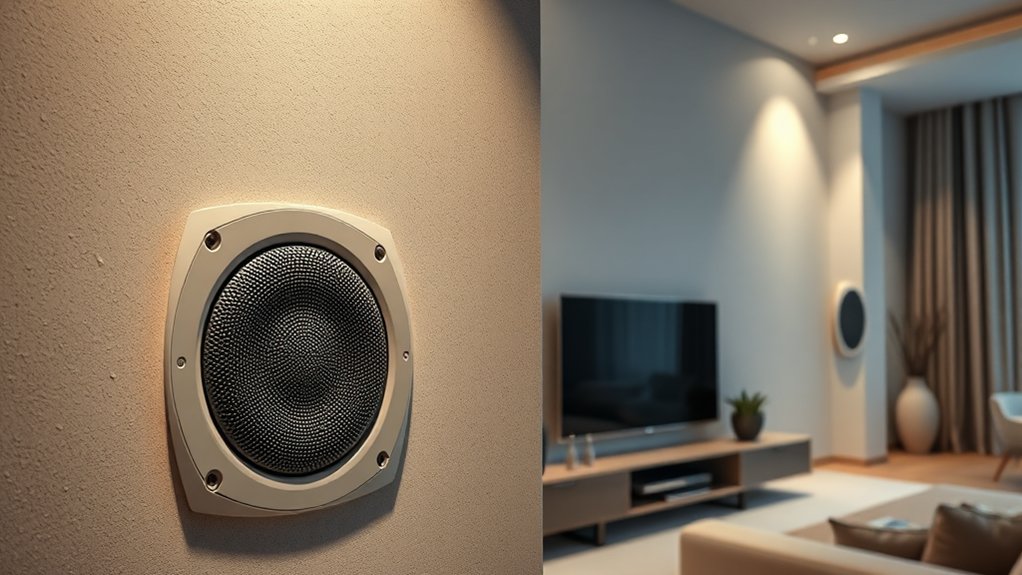
When you think about in-wall speakers, envision a sleek, unobtrusive sound system that effortlessly integrates into your home’s design as it delivers high-quality audio. These speakers often use a sealed cabinet design, which helps create a consistent sound output, no matter the wall construction. This means fewer sound leaks into adjacent rooms, making your audio experience more enjoyable (and your neighbors happier). The wall acts as a front baffle, enhancing low-frequency response. Furthermore, coaxial drivers, which combine tweeters and woofers, offer better sound dispersion and coherence. The in-wall versions of Soka and X4i loudspeakers provide advanced acoustic dispersion, further optimizing your listening experience. Additionally, using dedicated back boxes can significantly improve sound isolation and enhance overall performance.
Evaluating Sound Quality and Acoustic Performance
For an excellent home theater experience, evaluating sound quality and acoustic performance is just as important as understanding the design characteristics of your in-wall speakers.
Start by checking the frequency response; a flat response guarantees balanced sound across bass, midrange, and treble. Watch out for resonance peaks, especially around 200 Hz, which can muddy mid-bass. Additionally, many in-wall speakers exhibit poor overall performance at higher price points, emphasizing the need for careful consideration when selecting your model.
Checking the frequency response ensures balanced sound; avoid resonance peaks around 200 Hz that can muddy mid-bass.
Consider sensitivity ratings; speakers around 87 dB offer decent loudness without needing excessive amplification. Good dynamic range is crucial, meaning low distortion at high volumes guarantees your action movies sound impactful. This is particularly relevant when utilizing in-wall speakers as they can provide better sound quality due to their larger size.
Room interaction can either improve or ruin your experience—think of it like having a perfect stage for your performance!
Finally, proper alignment aids imaging, improving directional cues for that immersive feel.
Installation Considerations for In-Wall Speakers
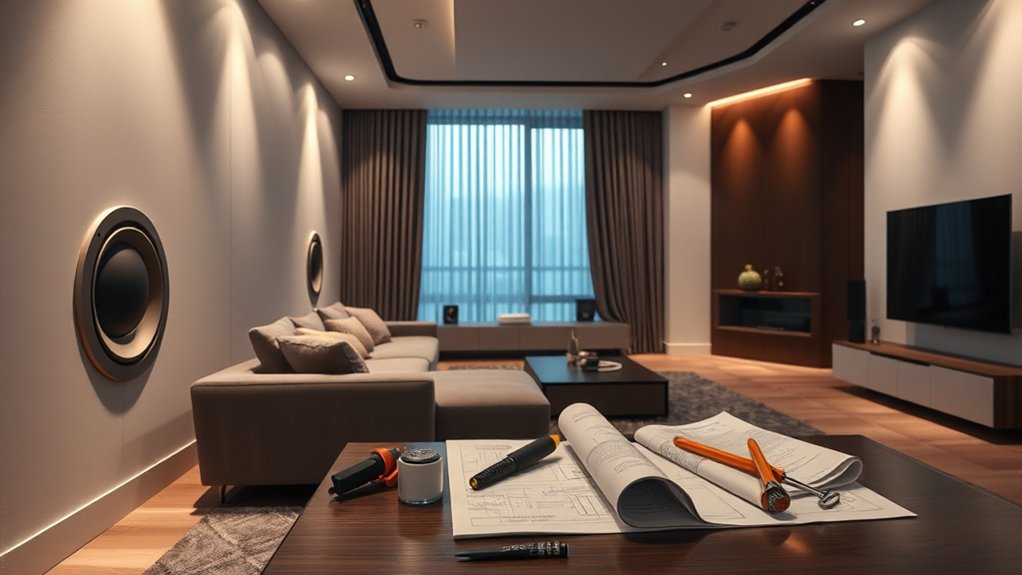
Installing in-wall speakers can feel like a challenging task, but don’t worry—approaching it methodically makes the process much smoother.
Start by using a stud finder to avoid accidental encounters with wiring. Make certain to pick wall cavities deep enough for your speakers, steering clear of pipes. Proper insulation behind speakers improves sound quality and minimizes leakage, so consider this crucial step.
Once you’ve marked your spots, use templates to cut the drywall neatly. Remember, no one wants to fix uneven edges!
When it’s time to connect wires, run CL2- or CL3-rated cables and label them for clarity.
And don’t forget: keep your speaker height around 40–42 inches for seated listeners—no one wants to strain their neck!
Room Layout and Speaker Placement Strategies
Have you ever wondered how the layout of your room affects your home theater experience? The strategic placement of your in-wall speakers is essential for ideal sound.
Position front left and right speakers at ear level for clarity—aiming them equidistant from your main seating creates balanced imaging. Surround speakers should be around 110 degrees from your listening position, enveloping you in sound.
Additionally, keep at least 18-24 inches between your speakers and walls, as this spacing reduces unwanted acoustic interference. Remember, speaker orientation matters too; angled mounts can direct sound precisely where you want it. Incorporating immersive audio technologies can significantly enhance your cinematic experience.
In short, good planning can transform your space into a cinematic dream—so don’t skimp on the details!
Brand and Model Recommendations for In-Wall Speakers
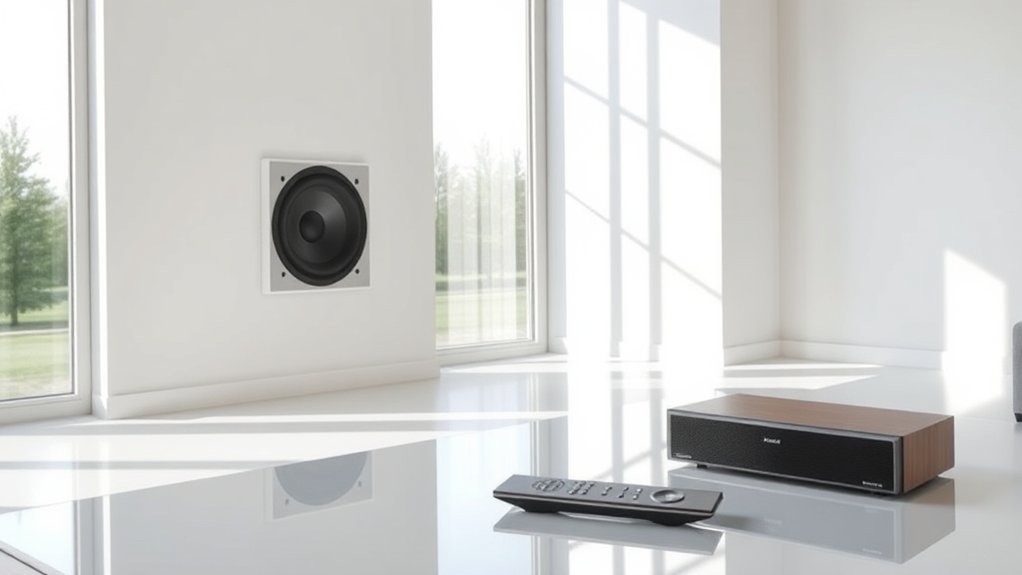
Regarding choosing in-wall speakers, you’ve got a wealth of options—think about the wide variety of brands and models available, each promising to improve your home theater experience.
For stellar audio, consider Sonance for its accurate sound and sleek designs. Bowers & Wilkins offers luxury aesthetics and impressive clarity, whereas MartinLogan excels with electrostatic technology for crisp highs.
For exceptional sound quality, explore Sonance for precision, Bowers & Wilkins for elegance, and MartinLogan for astonishing clarity.
If you prefer a modern look, check out Paradigm or Definitive Technology, which balance powerful bass with chic style.
And let’s not forget Revel and GoldenEar for more budget-friendly yet high-performance choices.
Eventually, choose based on your space, sound preferences, and, of course, eye for design—because who said speakers can’t be beautiful too?
System Configuration for Optimal Home Theater Experience
When you set out to configure your home theater system, it’s crucial to contemplate how the layout of your room—and the clever placement of your speakers—will impact your overall experience.
Start by measuring your room dimensions; this helps identify ideal speaker locations. For front left and right speakers, aim for a spacing that matches their distance from your main listening position, creating that beautifully balanced soundstage.
Don’t forget to angle them slightly inward (that toe-in thing!) to focus the sound right where you sit. Surround speakers should ideally sit just in front of you, as subwoofers love a central spot. Additionally, integrating a high-quality sound system like the HW-Q950A can elevate your audio enjoyment with its immersive Dolby Atmos experience that brings an enveloping sound environment to your home theater.
In the end, the beauty of sound comes from thoughtful placement, so invest the time to configure it right—your ears will thank you!
Tips for Calibration and Tuning Your In-Wall Speakers
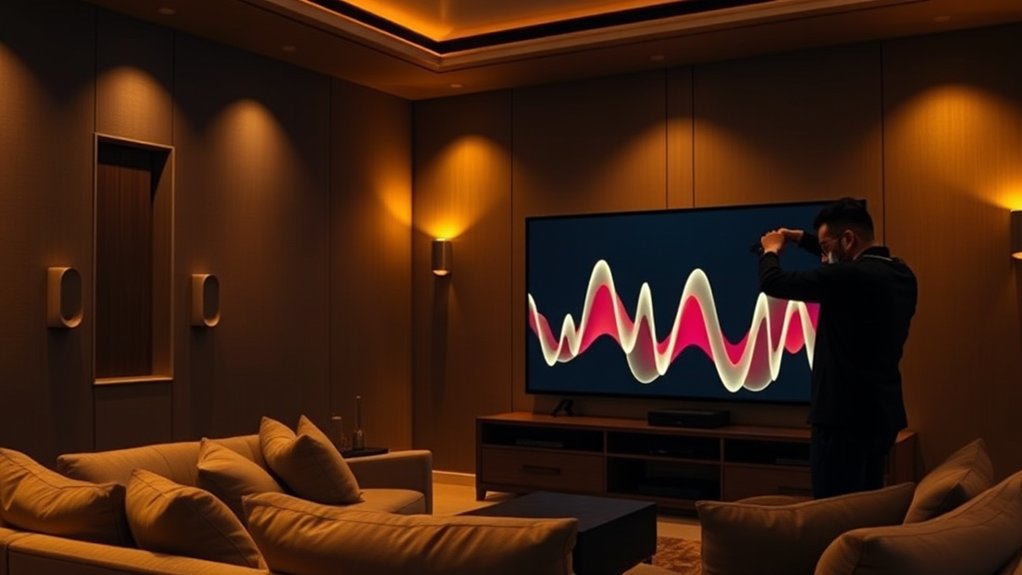
Although calibrating and tuning your in-wall speakers might sound like a challenging task, it’s actually quite manageable—and, dare we say, enjoyable!
Start by placing your measurement microphone at ear height (1.2 to 1.4 meters) in your main listening position. Next, verify your speakers are positioned correctly and then use a decibel meter to measure output levels, aiming for around 70 dB.
Trigger test tones from your receiver to balance each speaker’s volume at that point, compensating for distance differences. Remember, analyzing frequency response data will help flatten sound quality—just like adjusting your playlist for a smoother vibe! Additionally, consider integrating Dolby Atmos technology to enhance your sound experience further.
Use calibration software for precision, and don’t hesitate to re-measure after adjustments to confirm everything sounds just right. Happy tuning!
Frequently Asked Questions
How Do I Maintain My In-Wall Speakers?
To maintain your in-wall speakers, regularly wipe them with a microfiber cloth, guarantee ventilation openings are clear, and avoid exposure to dampness. Inspect wiring and connections periodically to keep your audio experience crisp and clear.
Can In-Wall Speakers Be Painted to Match My Walls?
Yes, you can paint in-wall speakers to match your walls. Just make certain you remove the scrim cloth, use high-quality spray paint, and avoid clogging perforations to maintain sound quality and aesthetic appeal.
What Is the Lifespan of In-Wall Speakers?
In-wall speakers typically last 20 to 25 years with proper care. High-quality models can survive decades, whereas lower-priced ones might only endure about five years. Environmental factors and regular maintenance greatly influence their longevity.
Are In-Wall Speakers Suitable for Outdoor Use?
In-wall speakers aren’t suitable for outdoor use except when they’re explicitly designed for it. They typically lack weatherproofing, which leads to degradation and damage from dampness, temperature changes, and UV exposure. Outdoor speakers are a better choice.
How Do I Troubleshoot Sound Issues With In-Wall Speakers?
To troubleshoot sound issues with in-wall speakers, check all connections for tightness, swap out faulty speakers, inspect wiring for damage, adjust receiver settings, and play test tones to evaluate each speaker’s operation.

